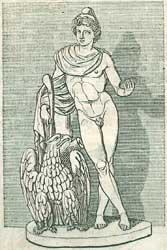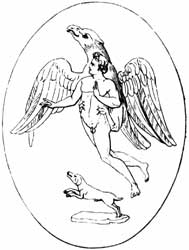Ganymede
"Gladdening." According to Homer and others, he was a son of Tros by Callirrhoe, and a brother of Ilus and Assaracus; being the most beautiful of all mortals, he was carried off by the gods that he might fill the cup of Zeus, and live among the eternal gods.1

The traditions about Ganymede, however, differ greatly in their detail, for some call him a son of Laomedon,2 others a son of Ilus,3 and others, again, of Erichthonius or Assaracus.4 The manner in which he was carried away from the earth is likewise differently described; for while Homer mentions the gods in general, later writers state that Zeus himself carried him off, either in his natural shape, or in the form of an eagle, or that he sent his eagle to fetch Ganymede into heaven.5
Other statements of later date seem to be no more than arbitrary interpretations foisted upon the genuine legend. Thus we are told that he was not carried off by any god, but either by Tantalus or Minos, that he was killed during the chase, and buried on the Mysian Olympus.6 One tradition, which has a somewhat more genuine appearance, stated that he was carried off by Eos.7 There is, further, no agreement as to the place where the event occurred.8
The early legend simply states that Ganymede was carried off that he might be the cup-bearer of Zeus, in which office he was conceived to have succeeded Hebe:9 but later writers describe him as the beloved and favorite of Zeus, without allusion to his office.10 Zeus compensated the father for his loss with the present of a pair of divine horses,11 and Hermes, who took the horses to Tros, at the same time comforted him by informing him that by the will of Zeus, Ganymede had become immortal and exempt from old age. Other writers state that the compensation which Zeus gave to Tros consisted of a golden vine.12

The idea of Ganymede being the cup-bearer of Zeus (urniger) subsequently gave rise to his identification with the divinity who was believed to preside over the sources of the Nile,13 and of his being placed by astronomers among the stars under the name of Aquarius.14
The Romans called Ganymede by a corrupt form of his name Catamitus.15 Ganymede was an appellation sometimes given to handsome slaves who officiated as cup-bearers.16
❧
Iconography
Ganymede was frequently represented in works of art as a beautiful (nude) youth with the Phrygian cap, and sometimes with a cloak draped across his shoulder. He appears either as the companion of Zeus,17 or in the act of being carried off by an eagle, or of giving food to an eagle from a patera. The abduction of Ganymede was a favorite subject on vase paintings and sculptures in late classical art. The bronze group by Leochares (fourth century BCE) shows an ascending eagle carrying Ganymede in its talons. The famous Dutch painter Rembrandt painted "De Geroofde Ganymedes" ("The Abducted Ganymede").
References
Notes
- Homer. Iliad xx, 231 ff.; Pindar. Olympian Odes i, 44; xii, in fin.; Pseudo-Apollodorus. The Library iii, 12.2.
- Cicero. Tusculanae Disputationes i, 22; Euripides. Trojan Women, 822.
- Tzetzes on Lycphron, 34.
- Hyginus. Fabulae, 224, 271.
- Pseudo-Apollodorus, l.c.; Virgil. Aeneid v, 253; Ovid. Metamorphoses x, 255; Lucian. Dialogues of the Gods, 4.
- Stephanus of Byzantium, s.v. Arpalia; Strabo. Geography xiii, p. 587; Eustathius on Homer, pp. 986, 1205.
- Scholiast on Apollonius Rhodius, iii, 115.
- Strabo, Stephanus of Byzantium ll.cc.; Horace. Carmina iii, 20, in fin.
- comp. Diodorus Siculus. Historical Library iv, 75; Virgil. Aeneid i, 28.
- Euripides. Orestes, 1392; Plato. Phaedrus, p. 255; Xenophon. Symposium viii, 30; Cicero. Tusculanae Disputationes iv, 33.
- Homer. Iliad v, 266, Hymn to Aphrodite, 202 ff.; Pseudo-Apollodorus. The Library ii, 5.9; Pausanias. Description of Greece v, 24.1
- Scholiast on Euripides' Orestes, 1399; Eustathius on Homer, p. 1697.
- Philostratus. Life of Apollonius of Tyana vi, 26; Pindar. Fragments Odes, 110 (ed. Böckh).
- Eratosthenes. Catasterismi, 26; Virgil. Georgics iii, 304; Hyginus. Fabulae, 224; Poetical Astronomy ii, 29.
- Plautus. Menaechmi i, 2.34.
- Petronius, 91; Martial. Epigrams ix, 37; Juvenal, v, 59.
- Pausanias. Description of Greece v, 24.1
Sources
- Aken, Dr. A.R.A. van. (1961). Elseviers Mythologische Encyclopedie. Amsterdam: Elsevier.
- Smith, William. (1870). Dictionary of Greek and Roman Biography and Mythology. London: Taylor, Walton, and Maberly.
This article incorporates text from Dictionary of Greek and Roman Biography and Mythology (1870) by William Smith, which is in the public domain.